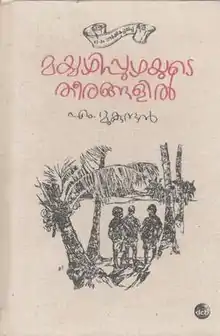Mayyazhippuzhayude Theerangalil
Mayyazhippuzhayude Theerangalil (transl. On the Banks of the Mayyazhi) is a Malayalam language novel by M. Mukundan. Widely regarded as the author's magnum opus, the novel vividly describes the political and social background of Mahé (Mayyazhi), the former French colony, in the past, in a mystical way.[1] The novel was translated into English and French, both the versions winning accolades.[2]
 41st anniversary edition cover | |
| Author | M. Mukundan |
|---|---|
| Country | India |
| Language | Malayalam |
| Genre | Fiction |
| Publisher | DC Books |
Publication date | 1974 |
Published in English | 1999 |
| Pages | 304 |
| ISBN | 978-8-171-30231-4 |
Historic background
The novel is based upon the lives of a few families of Mahé enclave. The new generation in Mahé wanted to merge the French enclave with India. The older people were loyal to the French rulers and believed in a romantic charm of the colonial rule. Two persons called Kanaran and Dasan take leadership of the fight against the French. The novel includes finer details about the romance of French rule in Mahé. The streets of Mahé with French names revoke an old charm. There is a christian church and many Hindu temples mentioned in the story. The story describes the first revolution when the activists removed the national flag from one of the government offices. This revolution was certainly a failure as the French navy came and the activists fled across the Mahé Bridge. The second and final revolution was however successful and the French rulers escaped by ship.
Plot summary
The protagonist in the novel is a young man called Dasan who was born in French Mahé and educated in Pondicherry. Even though he was offered a job in the French administration and assistance for higher education in Paris, he instead joins the freedom movement led by Gandhian Kanaran, and is attracted by communist ideology. A girl called Chandrika falls in love with him, but he is not able to promise her a married life because of his commitment to the revolution. A French court sentences Dasan to 12 years of imprisonment, but Dasan escapes captivity by walking across to the Indian Union. Very soon he comes back to Mahé leading a group of volunteers and frees Mahé from foreign rule. The French national flag is removed and the Indian national flag is hoisted on government buildings. Despite being a local hero Achu, he struggles for his livelihood as he refuses to accept regular employment and join the mainstream lifestyle. His girlfriend is forced by her parents to marry another man, so she commits suicide. Dasan also follows her way to reach the abode of the soul on the Velliyamkallu island on the Mahé coast.
Characters
- Dasan, the protagonist
- Chandrika, Dasan's girlfriend
- Kunjananthan, Teacher of Dasan, revolutionary
- Kanaretttan, freedom fighter
- Mooppan, French administrator (Big Sayiv)
- Unni Nair, French loyalist and bar owner
- Damu Writer , Dasan's father
- Pappan, revolutionary
- Kunhichirutha, courtesan
- Karunan, French officer
- Kurumbi Amma, grandmother of Dasan and French loyalist.
- Leslie, French magistrate
- Achu, the village criminal
- Chekku Mooppar, mayor
- David, French officer
- Kowsu, Dasan's mother
- Kunjakkan, the lamp-lighter[3]
- Kunjanan, French loyalist
- Bharathan, Chandrika's Father
- Leela, Chandrika's Mother
- Ghirija, dasan's sister
- Achu , husband of Ghirija, A local hero
French named streets of Mahé
- Rue de la Prison
- Rue du Gouvernement
- Rue de l'église (Church Road)
- Rue de la Residence[4]
Translations
- English: 1999. On the Banks of the Mayyazhi. Trans. Gita Krishnankutty. Chennai: Manas.
- French: 2002. Sur les rives du fleuve Mahé. Trans. Sophie Bastide-Foltz. Actes Sud.
In popular culture
- The characters of Mukundan in the novel are depicted in the form of a stone mural on Mahé Walk in Mahé. The Velliyankallu island described in the novel is also seen from the walkway.[5]
- A short film in Malayalam language called BONJOUR MAYYAZHI tells the story of the characters of the novel Mayyazhippuzhayude Theerangalil coming back and questioning the novelist.[6]